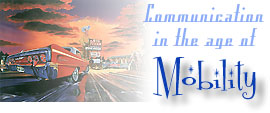
Office: HGH 210; phone: (408) 924-5378
Email: wooda@email.sjsu.edu
Web: http://www.sjsu.edu/faculty/wooda
 |
Dr. Andrew Wood Office: HGH 210; phone: (408) 924-5378 Email: wooda@email.sjsu.edu Web: http://www.sjsu.edu/faculty/wooda |
Introduction
: Course Calendar : Policies
: Readings
Assignments : Check Your Grades : Return
to Frontpage
Reading: Patton, P. (1997). Road to nowhere In J. Brouws, B. Polster, & P. Patton's (Eds.), Highway: America's endless dream (pp. 32-54). New York: Stewart, Tabori & Chang.
Study guide: Focus on (1) highway that is closest to American soul, (2) famous American gridded city, (3) experience of the road in Nabokov's book, (4) experience of the road in Kerouac's book, (5) first "magic motorway."
While appearing to provide yet another account of the interstate highway system, Patton's essay provides a perfect introduction to the final move this class makes: an investigation into the connection between fluid movement and American identity. In this piece, Patton explores the mythology of the road, weaving together blues music, diasporadic literature, and consumer fantasies of highway-freedom. Along the way, he offers a simple thesis: the road is not simply a way of getting from place to place; the road is where America "is at." As we've discussed before, even our cities - citadels of permanence - locate themselves according to the highways. Moreover, some communities - so-called edge cities - would not exist if not for the convergence of interstate highways (and, frequently, shopping malls).
The "grid" provides an essential manifestation of interstate-life. Often organized by roads, the grid shapes nature according to human designs, adapting it for human purposes. While many European cities organize themselves around natural features, human monuments, or even spiritual sites, most American cities - particularly those in the West - emerge as products of the grid. Within this grid, Americans find themselves - and lose themselves, a freedom that affirms a way of life: "How could Bolshevism flourish in a motorized country . . ." (p. 42)? This vision, sold through manufactured fantasies such as the 1939 New York World's Fair, helped shape two generations of federal support for the interstate highway system.
Inspired by the Fair's "Futurama" exhibit, the Pennsylvania Turnpike launched the nation on a road-building binge - and fueled an explosion of architectural experimentation: motels, cafes, gas stations, and other fluid locales: impermanent structures built to facilitate constant movement. Though slowed by World War II, this phenomenon reached its zenith in the Eisenhower-era interstate highway system. Built presumably to aid national defense, the interstate - like the internet - became a force all its own. Boosters often praised this force as a means to unify Americans, to dislodge the provincialism and regionalism of a young nation. But, as Patton argues persuasively, they missed the point: "The Interstates were created not so much to bind the nation together as to keep things flowing" (p.53).
Activity
Bring in a road song on CD - one either mentioned by Patton or one that reflects the spirit of the reading. For your Show and Tell activity, identify three specific themes of this song, relating them to concepts explored in class.